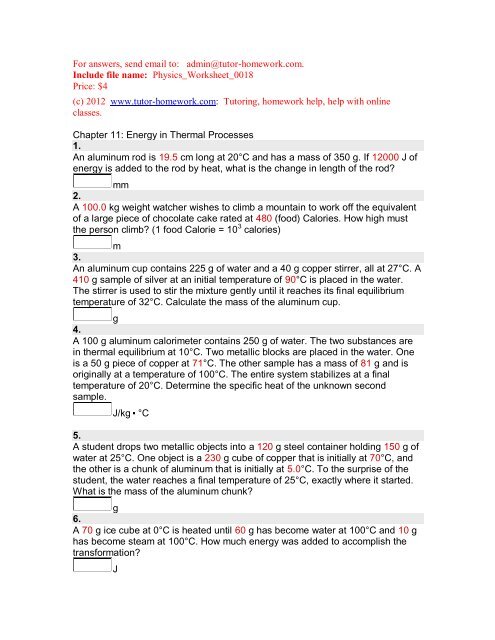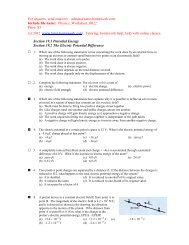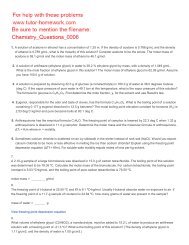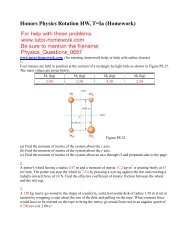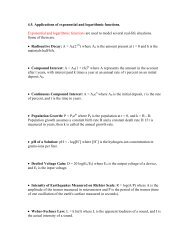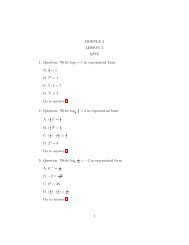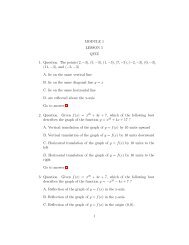Chapter 11: Energy in Thermal Processes - Tutor-Homework.com
Chapter 11: Energy in Thermal Processes - Tutor-Homework.com
Chapter 11: Energy in Thermal Processes - Tutor-Homework.com
You also want an ePaper? Increase the reach of your titles
YUMPU automatically turns print PDFs into web optimized ePapers that Google loves.
For answers, send email to: adm<strong>in</strong>@tutor-homework.<strong>com</strong>.Include file name: Physics_Worksheet_0018Price: $4(c) 2012 www.tutor-homework.<strong>com</strong>: <strong>Tutor</strong><strong>in</strong>g, homework help, help with onl<strong>in</strong>eclasses.<strong>Chapter</strong> <strong>11</strong>: <strong>Energy</strong> <strong>in</strong> <strong>Thermal</strong> <strong>Processes</strong>1.An alum<strong>in</strong>um rod is 19.5 cm long at 20°C and has a mass of 350 g. If 12000 J ofenergy is added to the rod by heat, what is the change <strong>in</strong> length of the rod?mm2.A 100.0 kg weight watcher wishes to climb a mounta<strong>in</strong> to work off the equivalentof a large piece of chocolate cake rated at 480 (food) Calories. How high mustthe person climb? (1 food Calorie = 10 3 calories)m3.An alum<strong>in</strong>um cup conta<strong>in</strong>s 225 g of water and a 40 g copper stirrer, all at 27°C. A410 g sample of silver at an <strong>in</strong>itial temperature of 90°C is placed <strong>in</strong> the water.The stirrer is used to stir the mixture gently until it reaches its f<strong>in</strong>al equilibriumtemperature of 32°C. Calculate the mass of the alum<strong>in</strong>um cup.g4.A 100 g alum<strong>in</strong>um calorimeter conta<strong>in</strong>s 250 g of water. The two substances are<strong>in</strong> thermal equilibrium at 10°C. Two metallic blocks are placed <strong>in</strong> the water. Oneis a 50 g piece of copper at 71°C. The other sample has a mass of 81 g and isorig<strong>in</strong>ally at a temperature of 100°C. The entire system stabilizes at a f<strong>in</strong>altemperature of 20°C. Determ<strong>in</strong>e the specific heat of the unknown secondsample.J/kg °C5.A student drops two metallic objects <strong>in</strong>to a 120 g steel conta<strong>in</strong>er hold<strong>in</strong>g 150 g ofwater at 25°C. One object is a 230 g cube of copper that is <strong>in</strong>itially at 70°C, andthe other is a chunk of alum<strong>in</strong>um that is <strong>in</strong>itially at 5.0°C. To the surprise of thestudent, the water reaches a f<strong>in</strong>al temperature of 25°C, exactly where it started.What is the mass of the alum<strong>in</strong>um chunk?g6.A 70 g ice cube at 0°C is heated until 60 g has be<strong>com</strong>e water at 100°C and 10 ghas be<strong>com</strong>e steam at 100°C. How much energy was added to ac<strong>com</strong>plish thetransformation?J
7.How much energy is required to change a 40 g ice cube from ice at -30°C tosteam at 140°C?J8.What mass of steam that is <strong>in</strong>itially at 130°C is needed to warm 290 g of waterand its 300 g alum<strong>in</strong>um conta<strong>in</strong>er from 20°C to 50°C?g9.A rest<strong>in</strong>g adult of average size converts chemical energy <strong>in</strong> food <strong>in</strong>to <strong>in</strong>ternalenergy at the rate of 120 W, called her basal metabolic rate. To stay at aconstant temperature, energy must be transferred out of the body at the samerate. Several processes exhaust energy from your body. Usually the mostimportant is thermal conduction <strong>in</strong>to the air <strong>in</strong> contact with your exposed sk<strong>in</strong>. Ifyou are not wear<strong>in</strong>g a hat, a convection current of warm air rises vertically fromyour head like a plume from a smokestack. Your body also loses energy byelectromagnetic radiation, by your exhal<strong>in</strong>g warm air, and by the evaporation ofperspiration. Now consider still another pathway for energy loss: moisture <strong>in</strong>exhaled breath. Suppose you breathe out 22.0 breaths per m<strong>in</strong>ute, each with avolume of 0.600 L. Suppose also that you <strong>in</strong>hale dry air and exhale air at 37°Cconta<strong>in</strong><strong>in</strong>g water vapor with a vapor pressure of 4.00 kPa. The vapor <strong>com</strong>es fromthe evaporation of liquid water <strong>in</strong> your body. Model the water vapor as an idealgas. Assume its latent heat of evaporation at 37°C is the same as its heat ofvaporization at 100°C. Calculate the rate at which you lose energy by exhal<strong>in</strong>ghumid air.W10.A 78 kg cross-country skier glides over snow as <strong>in</strong> Figure P<strong>11</strong>.25. The coefficientof friction between skis and snow is 0.30. Assume all the snow beneath his skisis at 0°C and that all the <strong>in</strong>ternal energy generated by friction is added to snow,which sticks to his skis until melted. How far would he have to ski to melt 2.0 kgof snow?m<strong>11</strong>.Figure P<strong>11</strong>.25
A 60.0 kg runner expends 335 W of power while runn<strong>in</strong>g a marathon (Fig.P<strong>11</strong>.28). Assum<strong>in</strong>g that <strong>11</strong>.0% of the energy is delivered to the muscle tissueand that the excess energy is primarily removed from the body by sweat<strong>in</strong>g,determ<strong>in</strong>e the volume of bodily fluid (assume it is water) lost per hour. (At 37.0°Cthe latent heat of vaporization of water is 2.41 10 6 J/kg.)cm 312.(a) F<strong>in</strong>d the rate of energy flow through a copper block of cross-sectional area 15cm 2 and length 5.0 cm when a temperature difference of 20°C is establishedacross the block.J/s(b) Repeat the calculation, assum<strong>in</strong>g that the material is a block of stagnant airwith the given dimensions.J/s(c) Repeat the calculation assum<strong>in</strong>g, that the material is a block of wood with thegiven dimensions.J/s13.A steam pipe is covered with 1.50 cm thick <strong>in</strong>sulat<strong>in</strong>g material with a thermalconductivity of 0.200 cal/cm °C s. How much energy is lost every second whenthe steam is at 190°C and the surround<strong>in</strong>g air is at 20.0°C? The pipe has acircumference of 800 cm and a length of 45.0 m. Neglect losses through theends of the pipe.MW14.A box with a total surface area of 1.20 m 2 and a wall thickness of 4.65 cm ismade of an <strong>in</strong>sulat<strong>in</strong>g material. A 10.0 W electric heater <strong>in</strong>side the box ma<strong>in</strong>ta<strong>in</strong>sthe <strong>in</strong>side temperature at 16.0°C above the outside temperature. F<strong>in</strong>d thethermal conductivity k of the <strong>in</strong>sulat<strong>in</strong>g material.W/m K15.A thermopane w<strong>in</strong>dow consists of two glass panes, each 0.50 cm thick, with a1.0 cm thick sealed layer of air <strong>in</strong> between. If the <strong>in</strong>side surface temperature is24.5°C and the outside surface temperature is 0.0°C, determ<strong>in</strong>e the rate ofenergy transfer through 2.0 m 2 of the w<strong>in</strong>dow. Compare your answer with therate of energy transfer through 2.0 m 2 of a s<strong>in</strong>gle 1.0 cm thick pane of glass.thermopane w<strong>in</strong>dowJ/ss<strong>in</strong>gle pane w<strong>in</strong>dowJ/s16.A copper rod and an alum<strong>in</strong>um rod of equal diameter are jo<strong>in</strong>ed end to end <strong>in</strong>good thermal contact. The temperature of the free end of the copper rod is held
constant at 100°C, and that of the far end of the alum<strong>in</strong>um rod is held at 0°C. Ifthe copper rod is 0.43 m long, what must be the length of the alum<strong>in</strong>um rod sothat the temperature at the junction is 50°C?m17.A Styrofoam box has a surface area of 0.85 m 2 and a wall thickness of 2.0 cm.The temperature of the <strong>in</strong>ner surface is 5.0°C, and the outside temperature is26°C. If it takes 8.6 h for 5.0 kg of ice to melt <strong>in</strong> the conta<strong>in</strong>er, determ<strong>in</strong>e thethermal conductivity of the Styrofoam.W/m K18.A sphere that is a perfect blackbody radiator has a radius of 0.050 m and is at220°C <strong>in</strong> a room where the temperature is 23°C. Calculate the net rate at whichthe sphere radiates energy.W19.The surface temperature of a particular star (similar to the Sun) is about 5700 K.Tak<strong>in</strong>g the radius of the star to be 6.96 10 8 m, calculate the total energyradiated by the star each second. (Assume e = 0.965.)W20.The bottom of a copper kettle has a 13.0 cm radius and is 2.1 mm thick. Thetemperature of the outside surface is 102°C, and the water <strong>in</strong>side the kettle isboil<strong>in</strong>g at 1 atm of pressure. F<strong>in</strong>d the rate at which energy is be<strong>in</strong>g transferredthrough the bottom of the kettle.J/s21.A water heater is operated by solar power. If the solar collector has an area of7.20 m 2 , and the <strong>in</strong>tensity delivered by sunlight is 650 W/m 2 , how long does ittake to <strong>in</strong>crease the temperature of 1.00 m 3 of water from 20.0°C to 55.0°C?h22.A 50 g ice cube floats <strong>in</strong> 190 g of water <strong>in</strong> a 100 g copper cup; all are at atemperature of 0°C. A piece of lead at 99°C is dropped <strong>in</strong>to the cup, and the f<strong>in</strong>alequilibrium temperature is 12°C. What is the mass of the lead?kg23.An iron plate is held aga<strong>in</strong>st an iron wheel so that a slid<strong>in</strong>g frictional force of 52 Nacts between the two pieces of metal. The relative speed at which the twosurfaces slide over each other is 32 m/s.(a) Calculate the rate at which mechanical energy is converted to <strong>in</strong>ternal energy.kW(b) The plate and the wheel have masses of 5.0 kg each, and each receives 50%
of the frictional heat. If the system is run as described for 10 s and each object isthen allowed to reach a uniform <strong>in</strong>ternal temperature, what is the resultanttemperature <strong>in</strong>crease?°C24.For bacteriological test<strong>in</strong>g of water supplies and <strong>in</strong> medical cl<strong>in</strong>ics, samples mustrout<strong>in</strong>ely be <strong>in</strong>cubated for 24 h at 37°C. A standard constant temperature bathwith electric heat<strong>in</strong>g and thermostatic control is not suitable <strong>in</strong> develop<strong>in</strong>g nationswithout cont<strong>in</strong>uously operat<strong>in</strong>g electric power l<strong>in</strong>es. Peace Corps volunteer andMIT eng<strong>in</strong>eer Amy Smith <strong>in</strong>vented a low cost, low ma<strong>in</strong>tenance <strong>in</strong>cubator to fillthe need. The device consists of a foam-<strong>in</strong>sulated box conta<strong>in</strong><strong>in</strong>g several packetsof a waxy material that melts at 37°C, <strong>in</strong>terspersed among tubes, dishes, orbottles conta<strong>in</strong><strong>in</strong>g the test samples and growth medium (food for bacteria).Outside the box, the waxy material is first melted by a stove or solar energycollector. Then it is put <strong>in</strong>to the box to keep the test samples warm as it solidifies.The heat of fusion of the phase-change material is 205 kJ/kg. Model the<strong>in</strong>sulation as a panel with surface area 0.460 m 2 , thickness 9.20 cm, andconductivity 0.0120 W/m °C. Assume the exterior temperature is 24.0°C for 12.0h and 18.0°C for 12.0 h.(a) What mass of the waxy material is required to conduct the bacteriologicaltest?kg(b) Expla<strong>in</strong> why your calculation can be done without know<strong>in</strong>g the mass of thetest samples or of the <strong>in</strong>sulation.


